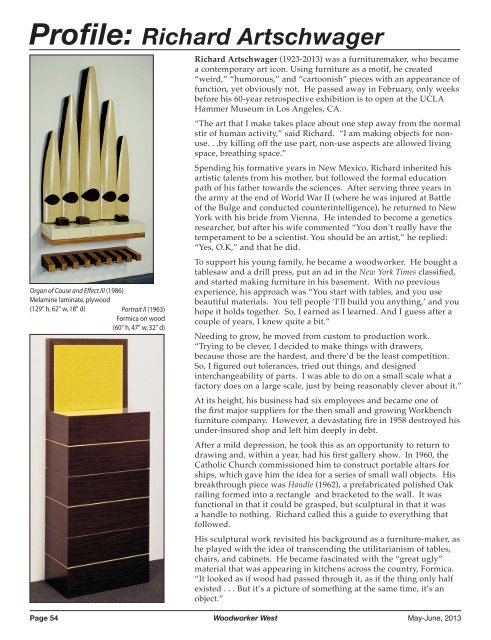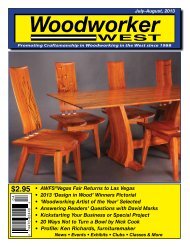Woodworker West (May-June, 2013)
Covering woodworking in the Western U.S. For the hobbyist to professional woodworker, furniture maker, woodturner, and anyone else working with wood.
Covering woodworking in the Western U.S. For the hobbyist to professional woodworker, furniture maker, woodturner, and anyone else working with wood.
You also want an ePaper? Increase the reach of your titles
YUMPU automatically turns print PDFs into web optimized ePapers that Google loves.
Profile: Richard Artschwager<br />
Organ of Cause and Effect III (1986)<br />
Melamine laminate, plywood<br />
(129" h, 62" w, 18" d) Portrait II (1963)<br />
Formica on wood<br />
(60" h, 47" w, 32" d)<br />
Richard Artschwager (1923-<strong>2013</strong>) was a furnituremaker, who became<br />
a contemporary art icon. Using furniture as a motif, he created<br />
“weird,” “humorous,” and “cartoonish” pieces with an appearance of<br />
function, yet obviously not. He passed away in February, only weeks<br />
before his 60-year retrospective exhibition is to open at the UCLA<br />
Hammer Museum in Los Angeles, CA.<br />
“The art that I make takes place about one step away from the normal<br />
stir of human activity,” said Richard. “I am making objects for nonuse.<br />
. .by killing off the use part, non-use aspects are allowed living<br />
space, breathing space.”<br />
Spending his formative years in New Mexico, Richard inherited his<br />
artistic talents from his mother, but followed the formal education<br />
path of his father towards the sciences. After serving three years in<br />
the army at the end of World War II (where he was injured at Battle<br />
of the Bulge and conducted counterintelligence), he returned to New<br />
York with his bride from Vienna. He intended to become a genetics<br />
researcher, but after his wife commented “You don’t really have the<br />
temperament to be a scientist. You should be an artist,” he replied:<br />
“Yes, O.K,” and that he did.<br />
To support his young family, he became a woodworker. He bought a<br />
tablesaw and a drill press, put an ad in the New York Times classified,<br />
and started making furniture in his basement. With no previous<br />
experience, his approach was “You start with tables, and you use<br />
beautiful materials. You tell people ‘I’ll build you anything,’ and you<br />
hope it holds together. So, I earned as I learned. And I guess after a<br />
couple of years, I knew quite a bit.”<br />
Needing to grow, he moved from custom to production work.<br />
“Trying to be clever, I decided to make things with drawers,<br />
because those are the hardest, and there’d be the least competition.<br />
So, I figured out tolerances, tried out things, and designed<br />
interchangeability of parts. I was able to do on a small scale what a<br />
factory does on a large scale, just by being reasonably clever about it.”<br />
At its height, his business had six employees and became one of<br />
the first major suppliers for the then small and growing Workbench<br />
furniture company. However, a devastating fire in 1958 destroyed his<br />
under-insured shop and left him deeply in debt.<br />
After a mild depression, he took this as an opportunity to return to<br />
drawing and, within a year, had his first gallery show. In 1960, the<br />
Catholic Church commissioned him to construct portable altars for<br />
ships, which gave him the idea for a series of small wall objects. His<br />
breakthrough piece was Handle (1962), a prefabricated polished Oak<br />
railing formed into a rectangle and bracketed to the wall. It was<br />
functional in that it could be grasped, but sculptural in that it was<br />
a handle to nothing. Richard called this a guide to everything that<br />
followed.<br />
His sculptural work revisited his background as a furniture-maker, as<br />
he played with the idea of transcending the utilitarianism of tables,<br />
chairs, and cabinets. He became fascinated with the “great ugly”<br />
material that was appearing in kitchens across the country, Formica.<br />
“It looked as if wood had passed through it, as if the thing only half<br />
existed . . . But it’s a picture of something at the same time, it’s an<br />
object.”<br />
Page 54 <strong>Woodworker</strong> <strong>West</strong> <strong>May</strong>-<strong>June</strong>, <strong>2013</strong>



